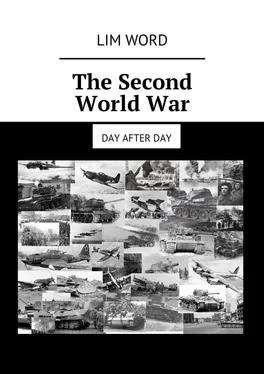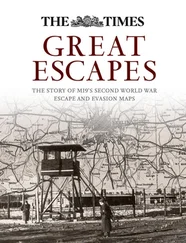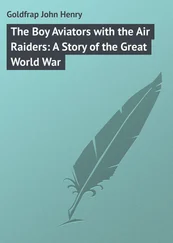Lim Word - The Second World War. Day after day
Здесь есть возможность читать онлайн «Lim Word - The Second World War. Day after day» — ознакомительный отрывок электронной книги совершенно бесплатно, а после прочтения отрывка купить полную версию. В некоторых случаях можно слушать аудио, скачать через торрент в формате fb2 и присутствует краткое содержание. ISBN: , Жанр: Политика, Справочники, Публицистика, История, на английском языке. Описание произведения, (предисловие) а так же отзывы посетителей доступны на портале библиотеки ЛибКат.
- Название:The Second World War. Day after day
- Автор:
- Жанр:
- Год:неизвестен
- ISBN:9785449071330
- Рейтинг книги:4 / 5. Голосов: 1
-
Избранное:Добавить в избранное
- Отзывы:
-
Ваша оценка:
- 80
- 1
- 2
- 3
- 4
- 5
The Second World War. Day after day: краткое содержание, описание и аннотация
Предлагаем к чтению аннотацию, описание, краткое содержание или предисловие (зависит от того, что написал сам автор книги «The Second World War. Day after day»). Если вы не нашли необходимую информацию о книге — напишите в комментариях, мы постараемся отыскать её.
The Second World War. Day after day — читать онлайн ознакомительный отрывок
Ниже представлен текст книги, разбитый по страницам. Система сохранения места последней прочитанной страницы, позволяет с удобством читать онлайн бесплатно книгу «The Second World War. Day after day», без необходимости каждый раз заново искать на чём Вы остановились. Поставьте закладку, и сможете в любой момент перейти на страницу, на которой закончили чтение.
Интервал:
Закладка:
In the course of their own civil war, on April 29, 1918, the White Finns capture Vyborg, arrange the genocide of all people who do not speak Finnish (retired military, schoolboys in Russian uniforms, even Poles). Three thousand people die.
On May 15, 1918, the Finnish government declared war on Soviet Russia. Its troops occupy, in particular, the Russian, from the 16th century, Pechenga, rename the name of this village in “Petsamo”. Later, large deposits of nickel ore will be explored here, since 1935 their industrial development by Anglo-American corporations will begin.
The Finnish military partially block Petrograd, contributing to the first great famine in this city (according to averaged data, one hundred thousand people become victims of it, as well as “red” terror). At the rate of Mannerheim, a plan for “national uprisings” is being developed, Finnish instructors are being allocated to create centers of insurgency. However, the plans of the Field Marshal to conquer East Karelia, the Kola Peninsula, the offensive against Petrograd, Germany does not support. After the Vyborg tragedy, any joint operations to overthrow the Bolshevik government along with the Finns, the White Army refuses to conduct either.
By May 1920, parts of the Red Army were eliminating the puppet North-Karelian state. In October of the same year, Finland and the USSR signed the Tartous Peace Treaty, according to which Russia was losing part of its territories. However, in 1921 Helsinki unleashed the second Soviet-Finnish war, by forces of “forest partisans” committing acts of sabotage and killing of supporters of Soviet power. The fighting ends in March 1922, a document is signed to ensure the inviolability of the Soviet-Finnish border. About 30,000 people dissatisfied with the new order go to Finland and, up to the end of the 1920s, armed groups formed from them, make raids on Soviet territory.
Whatever it was, the mood in Finland does not seem friendly to the Soviet government. His proposal – the removal of the border from Leningrad at the expense of Finland, in exchange for twice the size of the areas of East Karelia. Rent of the island of Hanko to create a Soviet military base. Disarmament and demolition of the “Mannerheim Line” on the Karelian Isthmus. Finland rejects these conditions.
Military operations begin after the delivery of an ultimatum, on November 30, 1939, from shelling (ships of the Baltic Fleet) and the bombing of Helsinki. The Soviet Union is excluded from the League of Nations. European countries supply Suomi with weapons, including free of charge (350 aircraft, 500 guns) and volunteers. For two months the columns of Soviet troops advancing along the forest roads are being cut by Finnish skiers, surrounded and destroyed. This is no longer the Halkin Gol. In February, having saturated the troops with heavy artillery and tanks, having increased the norms of food allowance, the USSR is making progress in the breakthrough of the Mannerheim Line; On March 13, Soviet troops enter Vyborg. The world lies. Irrevocable, severe losses of the USSR – 130 000 people, 650 tanks, 640 aircraft; Finns – 26 000 people, with 450 000 refugees, 62 aircraft. From the Finnish captivity, 4,354 people return, and are being filtered by the NKGB GUGB. 450 of them are released, the rest receive from 5 to 8 years of camps.
This military operation could have a special meaning if the USSR kept Petsamo (Pechenga) with the reserves of nickel ore, much needed by Germany’s military industry. However, the international community, including, above all, the UK, is strongly opposed. The area Petsamo returns to the Finns, and they organize a large-scale supply of nickel to the Axis countries.
Pechenga will join the Russian Federation only in 1944.
Among the advantages in the combat training of troops, after such a harsh school, is the abolition of the institution of political commissars, the experience of breaking through long-term fortifications, the winter war as a whole, and the return to production of a submachine gun (PAP).
Cons, in addition to the hardest losses – the German government understands that, in principle, is able to achieve all-round success in the war against the “colossus on clay feet”.
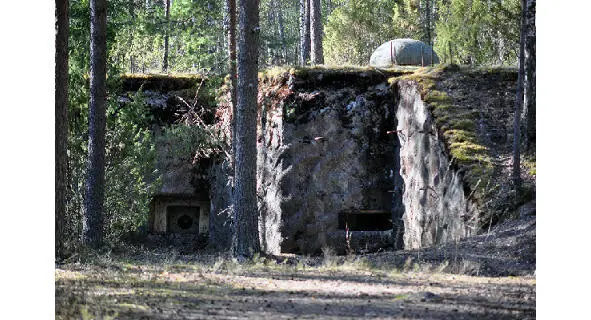
1. The Dot of the Mannerheim Line
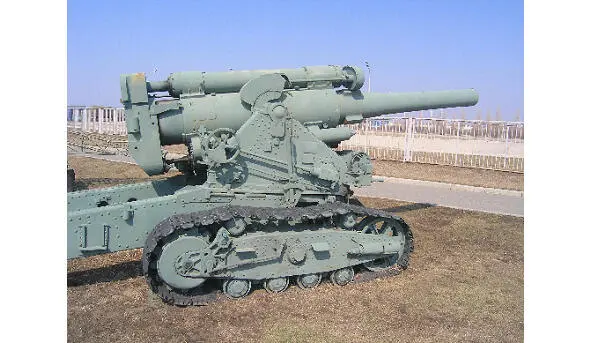
2. Howitzer B-4
1. The Dot of the Mannerheim Line
2. Howitzer B-4, caliber of 203 millimeters. The main hero of the Finnish war. The nickname “Karelian Sculptor”, for the fact that this instrument turns Finnish dots into a kind of avant-garde statues. The parameters of Finnish DOTs are “million”: the length is about 40 meters, the thickness of the walls of reinforced concrete is 2 meters. The result of action B-4 – if not the penetration of the walls, then the psychological impact on the defenders of the DOTs. Many of them, after a long bombardment of the B-4 went crazy.
The entry of the Baltic republics into the USSR
In October 1940, the Soviet Union invites Estonia, Latvia and Lithuania, under a mutual assistance agreement, to deploy a military contingent of 25,000 troops on their territory to defend themselves against Hitlerite Germany. It is already clear that the Red Army is inclined to achieve its goals, regardless of any losses. Two weeks later, the governments of these countries are accused of collusion with Germany (which is partly true), repressions against foreigners (Poles, etc.) and are shifting. In the summer of 1940, following the results of nationwide voting, the republics are formed by communist governments and adopt declarations of entry into the Soviet Union; which are immediately approved by the Supreme Soviet of the USSR.
According to the documents of the NKVD of June 17, 1941, in Lithuania, 5,663 people, mostly secret police officers and “classical capitalists”, were subject to detention, 10,186 in Latvia, 5,624 and 9,547 in Latvia respectively, and 3,179 and 5,979 in Estonia.
President of Lithuania Antanas Smyatona wisely emigrates to Germany, then Switzerland and the United States. His Estonian counterpart Konstantin Päts is deported with his family to Siberia, receives 25 years of camps, since 1942 is kept in a prison psychiatric clinic, he died there in 1956. The head of Latvia, Karlis Ulmanis convinces the people that “friends have come”, actively cooperates with the new, pro-Soviet government, and in particular, publishes the “Law on the fight against wrecking”. Somewhat later he begins to understand the situation, asks the Kremlin for permission to travel to Switzerland, but eventually ends up in the NKVD camp near Krasnovodsk (Turkmenistan), where, in 1942, he dies.
The Second World War
Occupation of Poland
The territories of Poland, acquired by Germany at the expense of Germany under the Treaty of Versailles (West Prussia and part of Silesia), prevent the Reich from uniting with East Prussia, the “cradle of German militarism”, its sacral center. After negotiations on the creation of a land corridor, or at least the transit of goods through Poland without bureaucratic obstacles, September 1, 1939, the invasion begins simultaneously from Germany, Slovakia and Prussia. The Polish Air Force, having existed for three days, shoots down 130 Luftwaffe aircraft. On September 22, the bombing of Warsaw begins: 1,150 aircraft drop 4,500 tons of bombs, and on September 28 the Polish military command (the civil government takes refuge in France) signs an act of surrender.
Читать дальшеИнтервал:
Закладка:
Похожие книги на «The Second World War. Day after day»
Представляем Вашему вниманию похожие книги на «The Second World War. Day after day» списком для выбора. Мы отобрали схожую по названию и смыслу литературу в надежде предоставить читателям больше вариантов отыскать новые, интересные, ещё непрочитанные произведения.
Обсуждение, отзывы о книге «The Second World War. Day after day» и просто собственные мнения читателей. Оставьте ваши комментарии, напишите, что Вы думаете о произведении, его смысле или главных героях. Укажите что конкретно понравилось, а что нет, и почему Вы так считаете.
